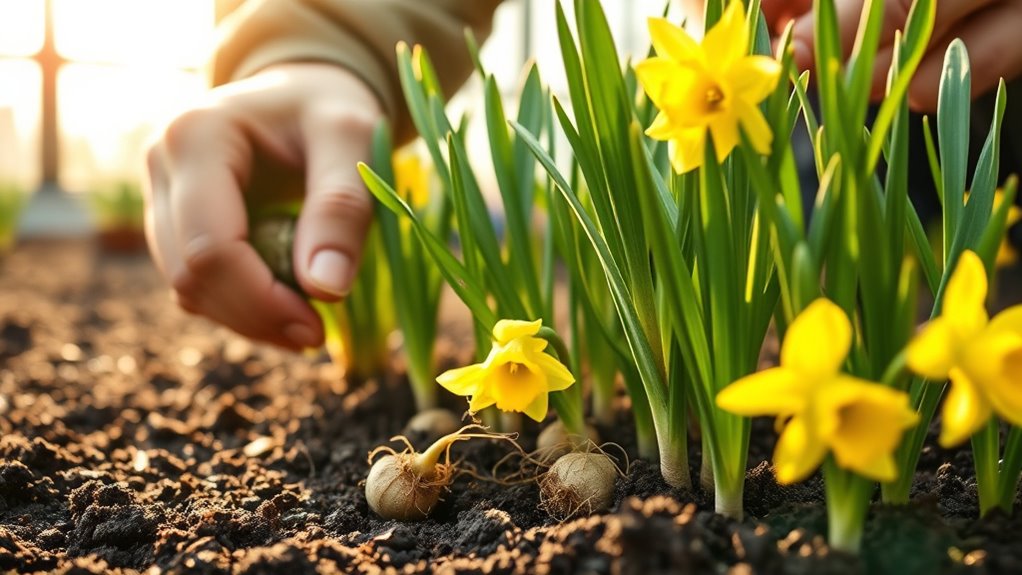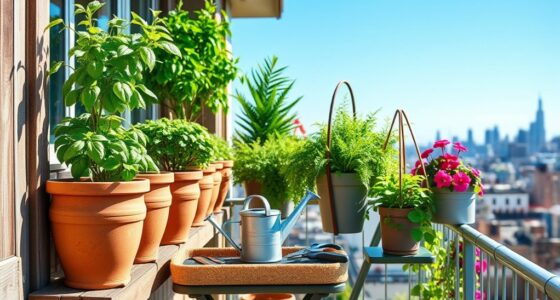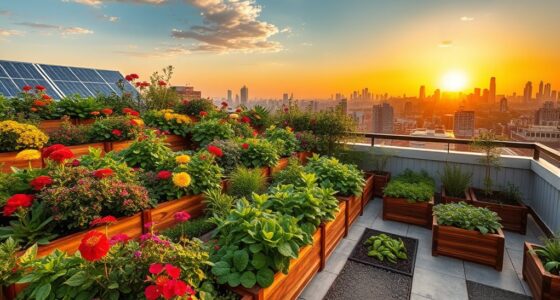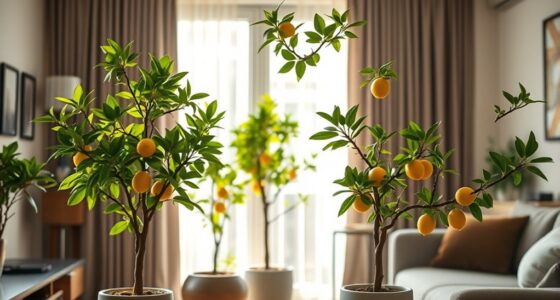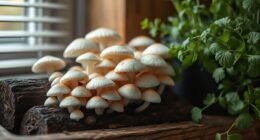To force bulbs indoors for winter blooms, choose healthy, large bulbs labeled for forcing like hyacinths, daffodils, or paperwhite narcissus. Chill them in a cool environment for 10-15 weeks, then gradually move them to warmer, brighter spotlights. Keep soil or water moist and avoid overwatering. Proper placement and timing can give you vibrant flowers right through winter. Want tips on mastering every step? Keep exploring to turn your space into a winter garden.
Key Takeaways
- Select healthy, large bulbs labeled for forcing, such as paperwhite narcissus or amaryllis, ensuring they are free from damage and mold.
- Chill bulbs in a cool, dark environment at 35-55°F for 10-15 weeks to promote flowering readiness.
- Plant bulbs in well-draining soil or position in water with the tip just above water level; provide bright, indirect light after chilling.
- Maintain cool room temperatures during blooming, keep soil moist, and remove spent flowers to extend bloom duration.
- Replant bulbs outdoors after flowering, allowing foliage to die back naturally, for future seasons of indoor forcing.
Choosing the Right Bulbs for Indoor Forcing
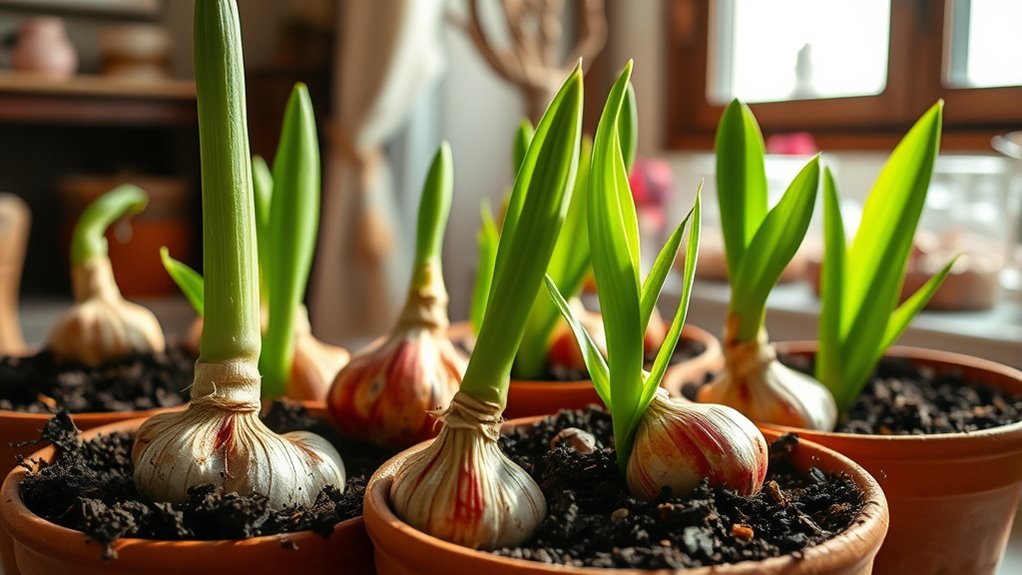
When choosing bulbs for indoor forcing, it’s vital to select high-quality, large, and firm specimens like paperwhite narcissus, amaryllis, hyacinths, tulips, or daffodils. These forcing bulbs should be flowering-sized, free from damage or disease, to guarantee vibrant blooms. Look for bulbs labeled as suitable for forcing, which indicates they’re ready for indoor growth. Soil isn’t involved until planting, but handling pre-chilled bulbs is important if they require a cold treatment beforehand. For immediate forcing, opt for pre-chilled bulbs or those that don’t need chilling, such as paperwhite narcissus and amaryllis. Proper selection guarantees healthy development and beautiful blooms, making it a critical first step for successful indoor forcing during winter. Additionally, proper storage of bulbs before planting can help maintain their vitality and ensure successful flowering. Maintaining appropriate storage conditions helps preserve bulb quality and flowering potential, ensuring vibrant indoor blooms during the colder months. Proper temperature and humidity control during storage can also prevent premature sprouting or rot, further supporting healthy growth.
Preparing Bulbs for Optimal Growth
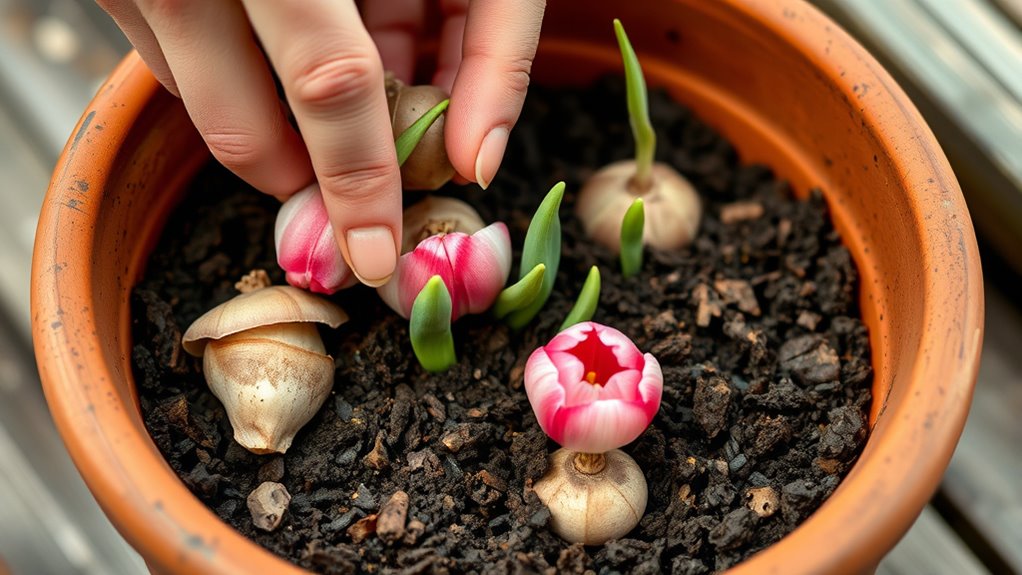
Preparing bulbs for ideal growth starts with selecting high-quality, firm specimens free from mold, soft spots, or signs of decay. Proper preparation guarantees healthy blooms indoors. Additionally, understanding financial management strategies can help you budget for gardening supplies and ensure ongoing success. To get started: 1. Water your bulbs lightly before storage, but avoid soaking them. 2. Store bulbs in a cool, dark place like a refrigerator or basement, in a mesh or paper bag, to chill them naturally. 3. For soil planting, position the bulb with the pointed tip just above the soil surface and cover with a thin layer of soil. 4. Label each bulb or container with variety and forcing date to coordinate blooming schedules. Chilling the bulbs mimics winter conditions, and keeping soil or water at the right level encourages strong roots and vibrant blooms. Proper bulb storage is key to successful forcing, and understanding plant biology can improve your overall success with indoor blooms. Maintaining appropriate temperature control during storage also plays a vital role in ensuring successful forcing. Additionally, paying attention to the correct timing for forcing bulbs ensures they bloom at the desired time, maximizing their visual impact indoors.
Planting Bulbs in Containers or Water
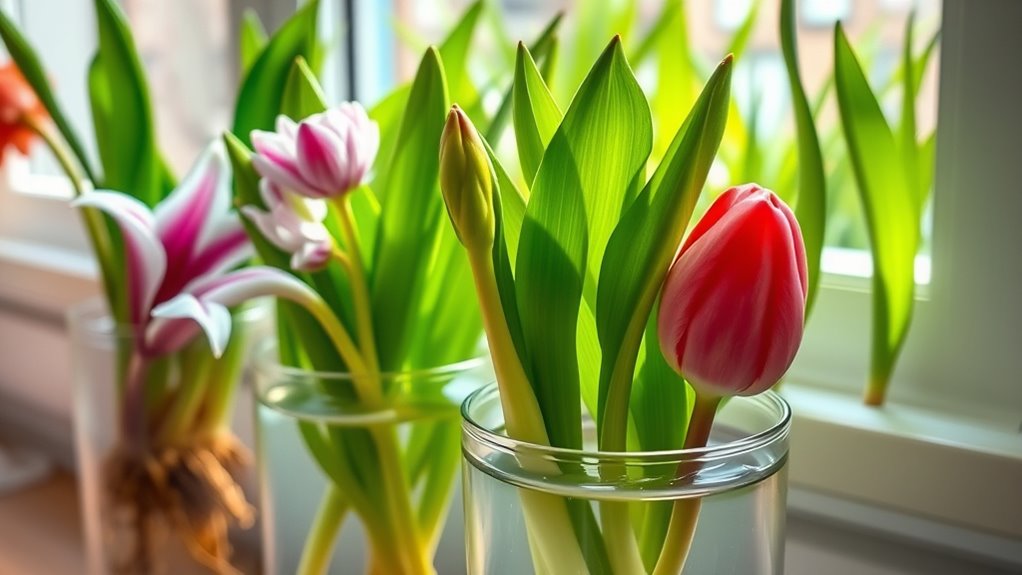
Planting bulbs in containers or water requires selecting healthy, firm specimens free from mold or soft spots to guarantee successful forcing. When planting in water, position bulbs tip-end up in a container with enough water to touch only the bottom 1/8 to 1/4 inch, avoiding submerging the base. Keep the soil moist but not soggy and monitor water levels in water forcing setups, adding water every three days to prevent dehydration. Choosing the right container and ensuring proper placement are essential for healthy root development, which can be influenced by the soil quality and environmental conditions. Additionally, maintaining optimal data privacy standards during setup ensures the process remains secure and effective. Proper environmental conditions such as temperature and light also play a critical role in successful forcing, especially considering the influence of seasonal changes on plant growth.
Managing the Chilling Process
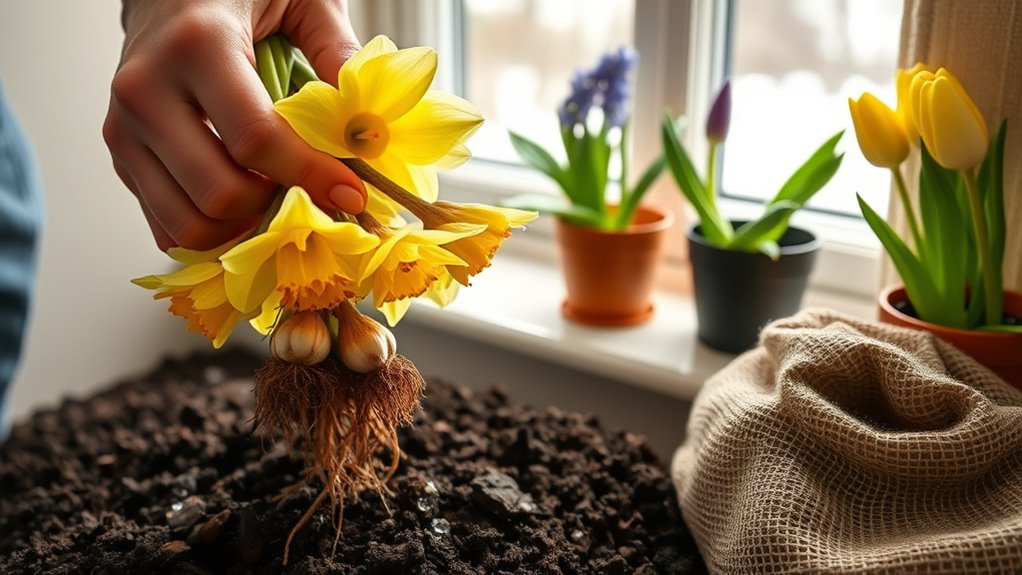
After placing your bulbs in containers or water and ensuring they’re healthy and properly rooted, the next step is managing the chilling process. This critical period guarantees bulbs indoors develop the necessary dormancy for blooming.
Here’s what you should do:
- Maintain a cool room at 35-55°F during the chilling period—avoid warm spots.
- Keep the soil or medium consistently moist, but not waterlogged, to promote root growth without rotting.
- If outdoors, bury pots in mulch or leaves, protecting them from freezing yet keeping temperatures cool.
- Check for white, whiskery roots emerging from drainage holes; this signals they’re ready to move to warmer, brighter conditions.
- Using crochet tools to gently handle roots can help prevent damage during transplanting.
- Monitoring temperature control is essential to ensure the bulbs experience the correct chilling duration for optimal flowering.
- Incorporating proper storage techniques can also help maintain the ideal environment and prevent premature sprouting or damage. Properly managing vegetable storage can further support healthy growth during dormancy.
Additionally, understanding the best vegetables to eat on a keto diet can inspire you to incorporate healthy, low-carb greens into your indoor planting space for added nutrition.
Proper management of the chilling period guarantees healthy root growth and successful flowering indoors.
Transitioning Bulbs to Warmer Conditions
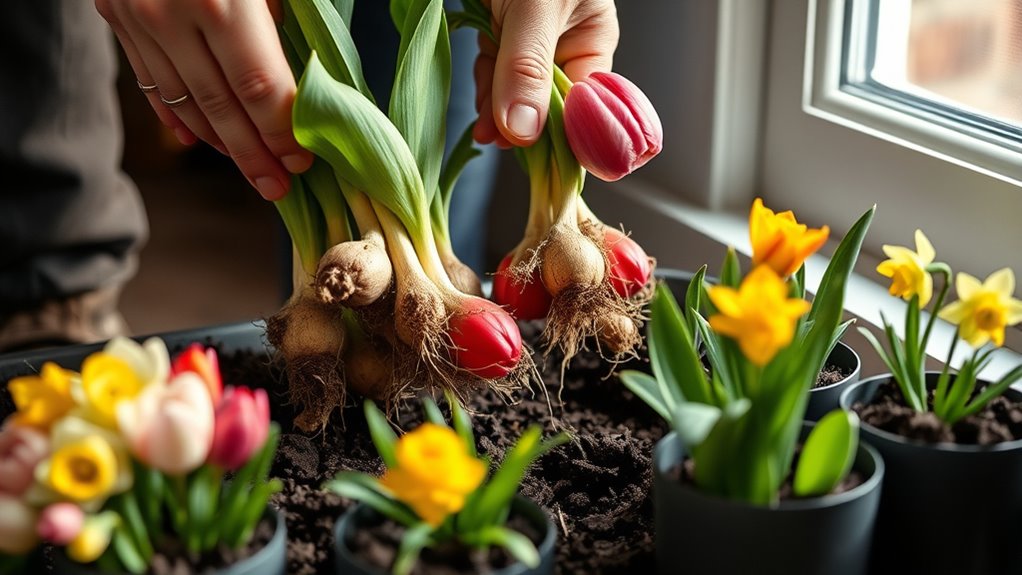
Once your bulbs have developed healthy roots and the shoots reach 2-4 inches, it’s time to gradually move them from the cold to a warmer, dimmer environment. Shifting should happen over one to two weeks to prevent shock and promote steady growth. Begin by placing the rooted bulbs in a warm spot around 65°F, such as a warm room or a protected area within your cold frame. Keep the environment dim at first, gradually increasing light exposure as the bulbs adapt. Avoid drafts, direct sunlight, and heating vents to maintain consistent warmth and prevent stress. Regular watering is essential, keeping the soil moist but not waterlogged during this transition. This gradual change helps the bulbs adjust smoothly to their new environment, encouraging healthy flowering. Additionally, monitoring for signs of spoilage or stress ensures the bulbs remain healthy during the transition. Incorporating temperature regulation can further support a successful adaptation period. Proper light management is also key to ensuring the bulbs develop strong blooms indoors. Consistent watering and gradual acclimatization are vital to prevent transplant shock and promote vibrant blooms. It’s also beneficial to observe the bulbs regularly for any pest or disease issues, which could hinder their growth during this sensitive period.
Encouraging Healthy Growth and Flowering
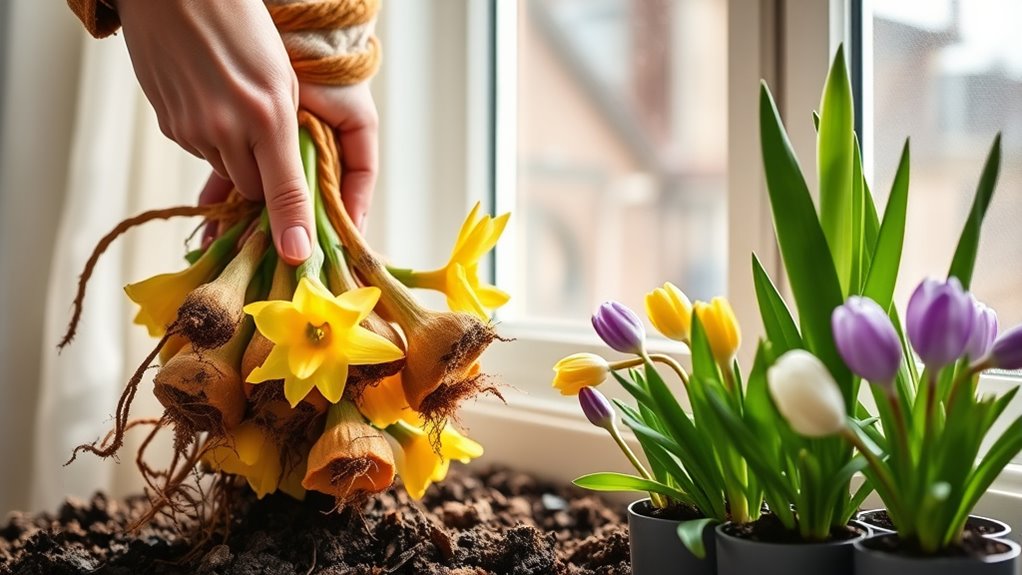
To encourage healthy growth and vibrant blooms, you need to focus on providing the right light and water. Keep the bulbs in bright, indirect light and maintain consistent moisture without overwatering. Additionally, proper chilling techniques help set the stage for strong flowering stems. Using a proper placement that allows for adequate airflow can also promote healthier growth and reduce the risk of mold or rot.
Proper Chilling Techniques
Proper chilling techniques are vital for encouraging healthy growth and flowering in bulbs. To guarantee success, you need to follow these steps:
- Store bulbs in a cool, dark environment such as an unheated garage or cellar during the chilling period.
- Keep the soil or medium moist but not soggy to promote root development without risking rot.
- Maintain a temperature between 35-55°F for 10-15 weeks, which is essential for breaking dormancy.
- Avoid exposure to ethylene gas from fruits, as it can hinder the chilling process.
Optimal Light and Water
Providing the right amount of light and water is essential for healthy bulb growth and vibrant flowering indoors. Place your bulbs near a bright window, preferably east- or south-facing, to give them indirect light that promotes strong, upright shoots.
Keep the soil or water moist but never waterlogged; water when the top inch feels dry, and ensure excess water can drain freely from the bottom of the pot. Use well-draining potting soil to prevent soggy roots, which can cause rot.
For water-grown bulbs, replenish the water every three days, making sure the roots stay consistently moist.
During flowering, maintain cool room temperatures below 65°F to extend bloom life and support healthy, striking flowers.
Proper light and watering create ideal conditions for indoor bulb success.
Common Challenges and Troubleshooting Tips
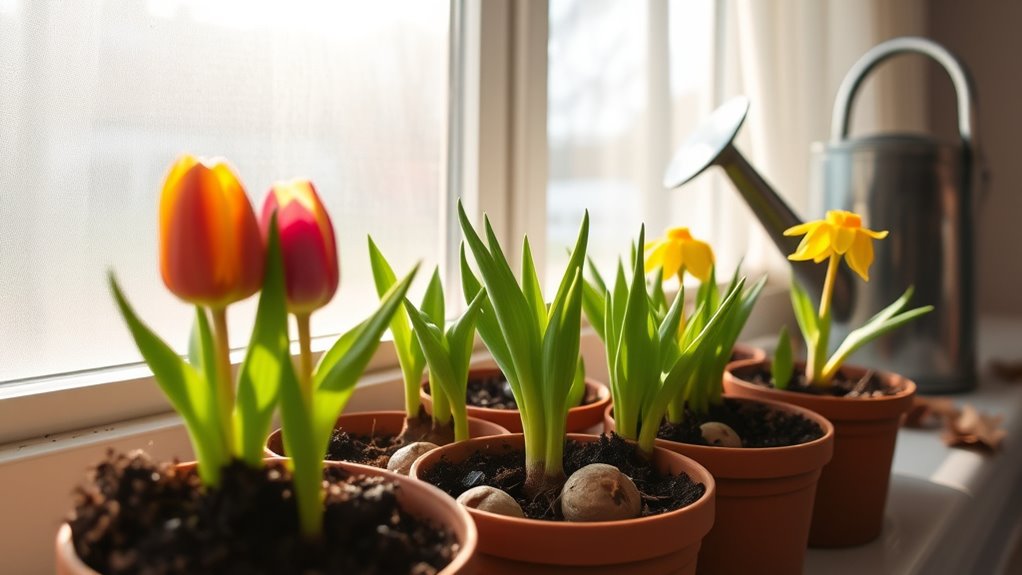
Growing bulbs indoors for winter blooms can be rewarding, but several common issues may arise if conditions aren’t just right.
- Make sure you provide the correct chilling time; insufficient cold duration can cause weak blooms or no blooms at all.
- When chilling, bulbs should be placed in a cool, dry spot, and avoid overwatering, which can lead to rot and root problems.
- Poor lighting after removing bulbs from cold storage makes stems leggy and blooms colorless. Ensure bright, indirect light to encourage healthy growth.
- Don’t plant bulbs too deeply or use containers without proper drainage—these mistakes can cause mold, rot, or failure to bloom.
Addressing these challenges helps guarantee vibrant, healthy winter blooms.
Extending Blooming Period Indoors
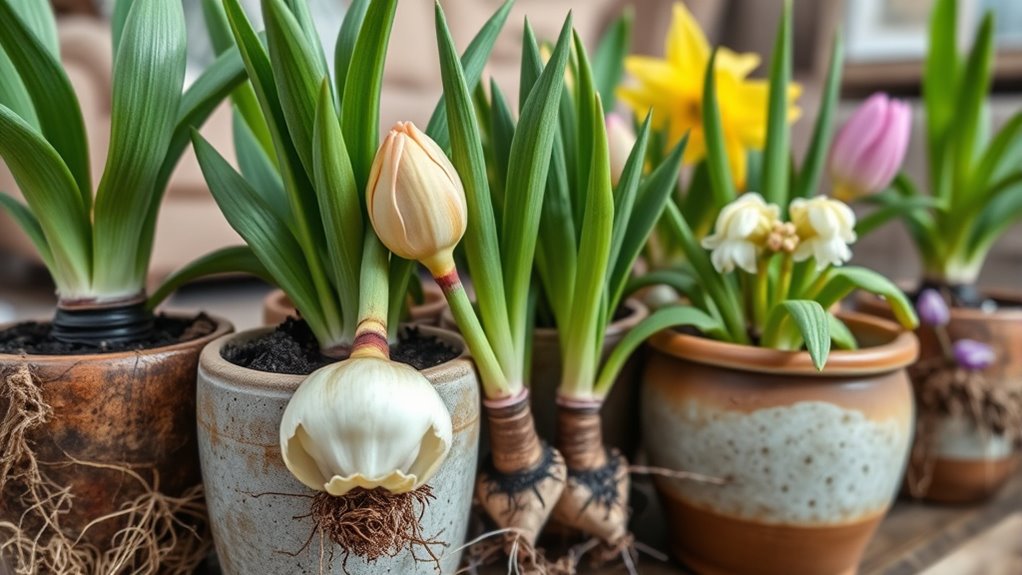
To enjoy your indoor bulbs for as long as possible, timing their planting and chilling periods carefully is vital, especially if you want them to bloom during specific dates like holidays or winter.
Maintaining cool temperatures around 60°F during the flowering stage helps prolong indoor blooms, often up to two weeks or more.
When forcing bulbs, make sure they receive consistent, indirect light to prevent legginess and keep the blooms vibrant.
Proper watering is essential; keep the soil or water moist but not waterlogged to support healthy growth and extend bloom life.
Remove spent flowers promptly to encourage new growth and adjust temperature conditions when necessary.
Reusing and Replanting Bulbs for Future Blooms
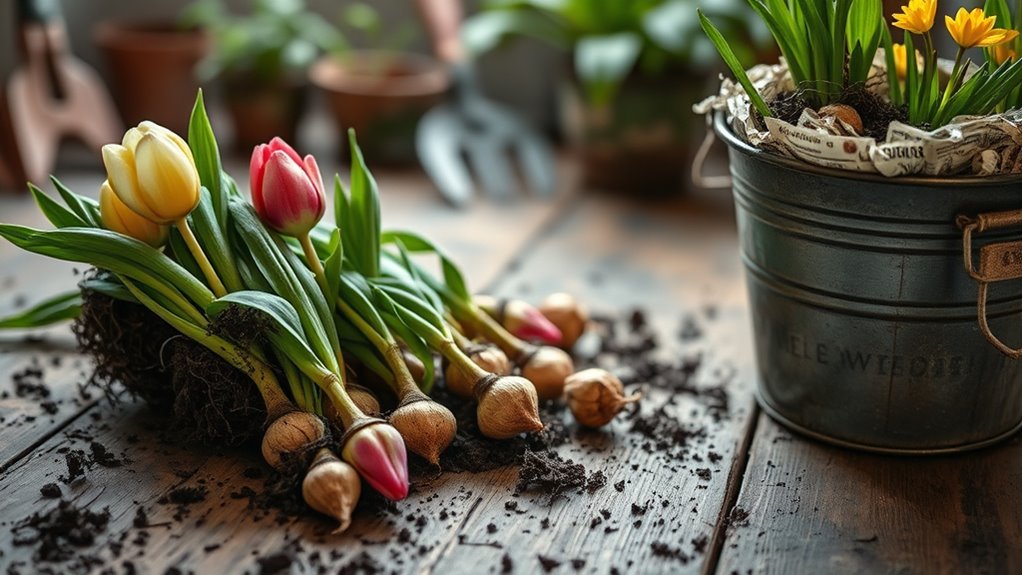
After your bulbs have finished blooming indoors, you can replant them outside to encourage future flowers. Make sure the foliage has fully died back before replanting.
Store the bulbs in a cool, dry place if needed. Proper replanting depth and aftercare will help guarantee healthy growth and vibrant blooms next season.
Proper Post-Forcing Care
Once your bulbs have finished flowering indoors, it’s vital to care for them properly to guarantee they can rebloom in the future. Proper post-forcing care involves a few key steps:
- Let the foliage die back naturally—don’t cut it prematurely, as this allows the bulb to store energy.
- Once the leaves yellow and dry, carefully remove the bulb from the soil and clean off any old roots or debris.
- Store bulbs in a dark location with good air circulation, in a cool, dry place.
- Replant them outdoors in well-drained soil with organic matter when the growing season begins, ensuring proper watering and sunlight for healthy growth.
Following these steps helps ensure your bulbs will bloom again.
Best Replanting Practices
Replanting bulbs correctly guarantees they thrive and bloom again in future seasons. After your indoor blooms fade, allow the foliage to die back naturally, which supports proper bulb care by enabling nutrient recovery.
Store the bulbs in a cool, dry, well-ventilated area, such as a paper bag in your basement or garage, until it’s time to replant. During the cooling period, ensure bulbs are kept at the right temperature to prepare them for dormancy and the next cycle of indoor blooms.
When replanting, use well-draining soil and plant bulbs at a depth two to three times their height. Dividing clumps during dormancy can rejuvenate plants and increase future blooms, providing vibrant displays year after year.
Frequently Asked Questions
How Do You Force Bulbs Indoors in Winter?
To force bulbs indoors in winter, start by choosing healthy, large bulbs like hyacinths, tulips, or daffodils.
Plant them in well-draining pots, pointed end up, and chill them in the fridge at 35-48°F for 10-15 weeks.
Once roots develop, slowly bring the pots to warmer, brighter spots.
Keep the environment cool and moist, and watch for shoots and blooms to enjoy early spring color indoors.
What Bulbs Are Best to Force Inside?
Think of your indoor garden as a stage where bulbs perform their spring debut. You’ll find hyacinths and paperwhite narcissus steal the show with quick blooms and minimal fuss.
Daffodils, especially Trumpet and Tazetta, can encore if cared for properly. For a more challenging act, try tulips, which require patience but reward you with stunning color.
Bulbs like amaryllis and crocuses are reliable stars for a successful indoor bloom.
How to Force Flowers to Bloom Indoors?
To force flowers to bloom indoors, start with healthy bulbs like hyacinths, daffodils, or tulips. Plant them in well-draining pots, with the tips exposed.
Then chill them at 35-55°F for 10-15 weeks. After roots develop and shoots reach 2-4 inches, move the bulbs to a bright, cool spot around 65°F.
Keep the soil moist, and soon, your flowers will bloom indoors, brightening your winter days.
How to Force Narcissus Bulbs Indoors?
To force narcissus bulbs indoors, start by pre-chilling them in a cool, dark place for 10-15 weeks at 35-55°F.
After chilling, plant the bulbs in well-draining soil or place them tip-up in pebbles or a forcing jar with water.
Keep them in a cool, bright spot once roots and shoots develop, and guarantee they stay moist.
You’ll enjoy blooms in just a few weeks!
Conclusion
By following these steps, you’ll transform your home into a winter garden, much like nurturing a delicate treasure. With patience and care, your bulbs will reward you with vibrant blooms that brighten even the gloomiest days. Think of it as planting hope indoors—each blossom a reminder that beauty can flourish against all odds. Embrace the process, and soon you’ll enjoy a burst of springtime cheer, no matter how cold outside.
